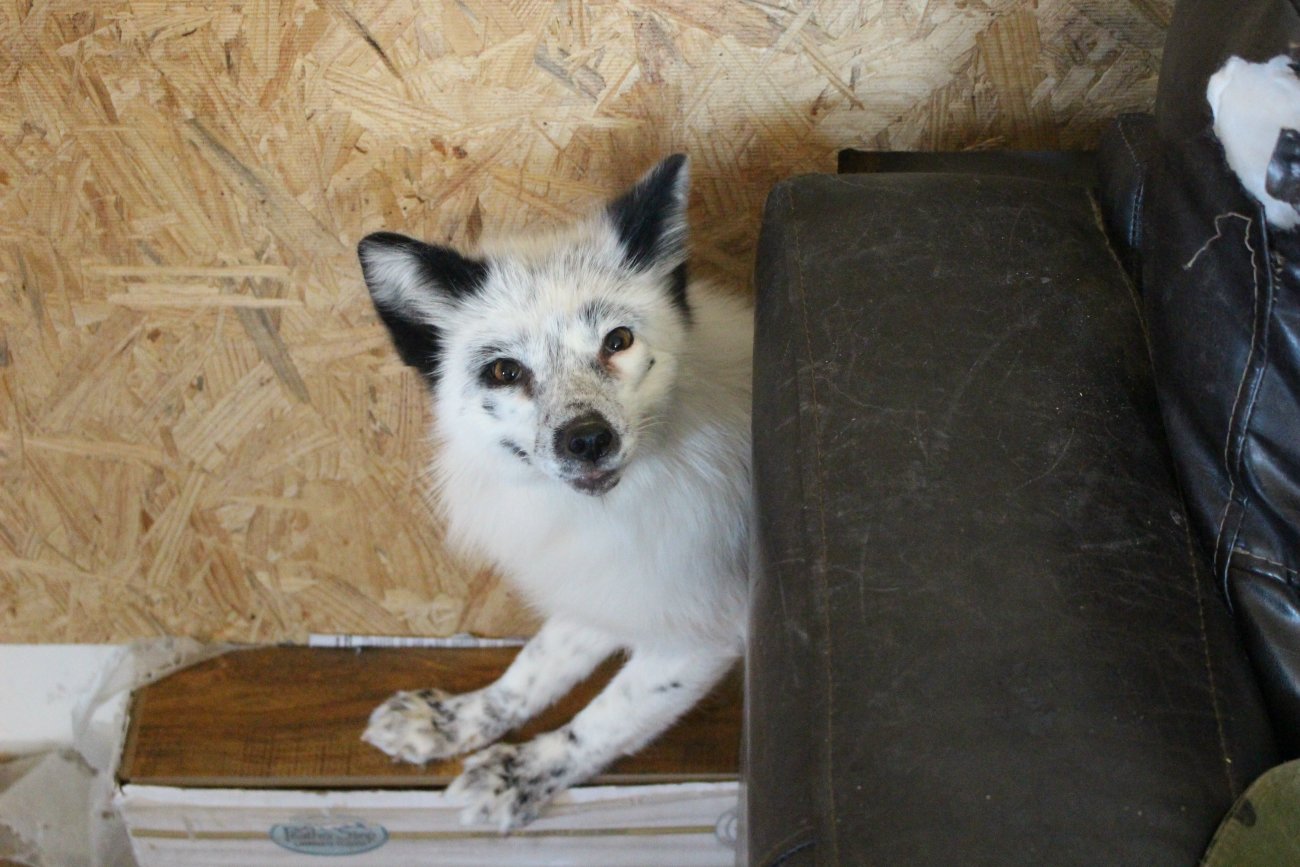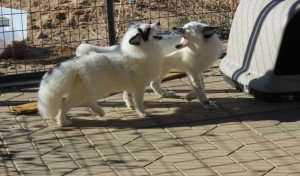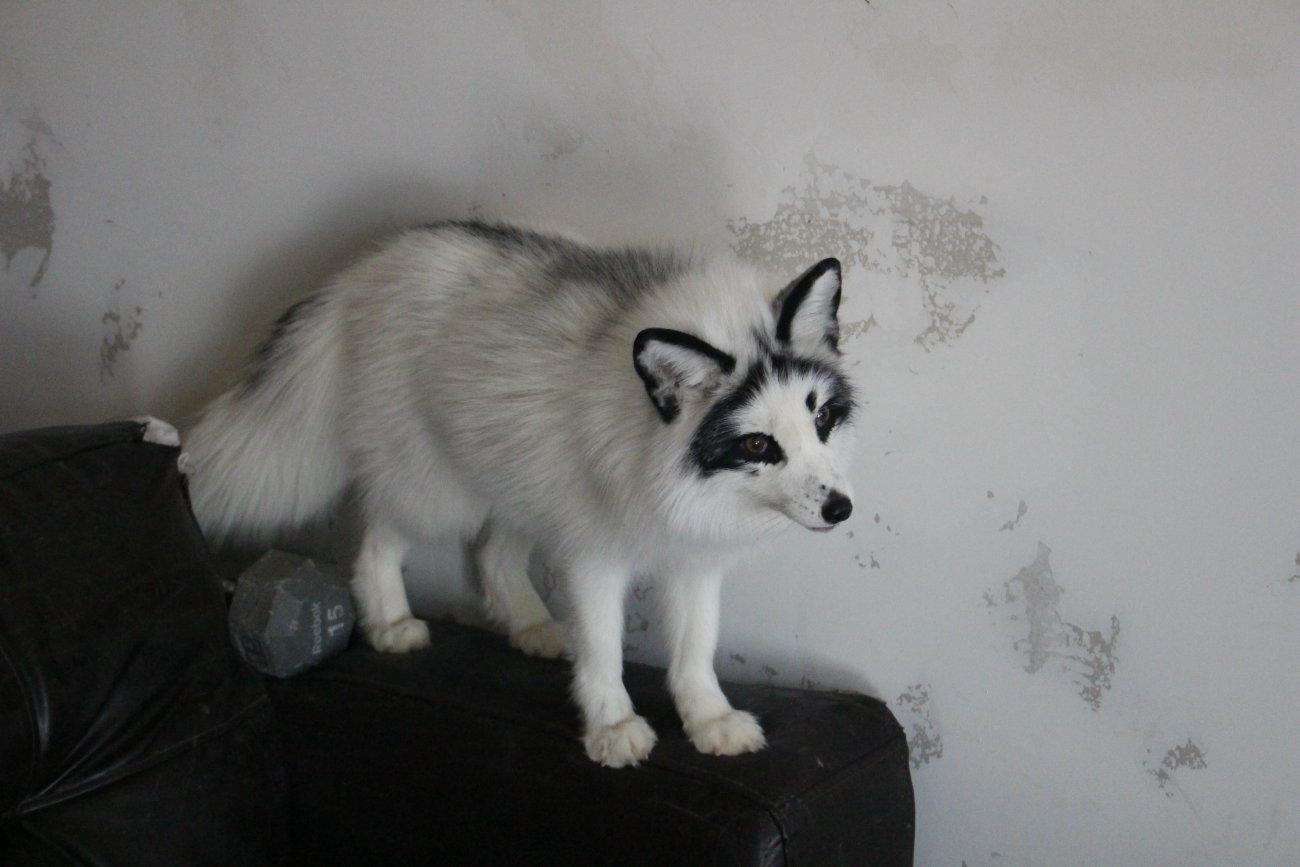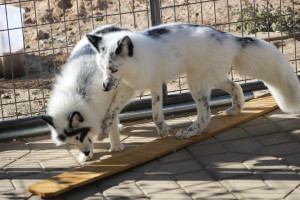ST. GEORGE – Ever think of a fox as a possible candidate for a search and rescue animal? This is what a couple out of San Diego originally, now residents of Southern Utah, considered after hearing about foxes being raised in Russia as part of a domestication experiment.

While initial plans didn’t quite work out as hoped, the couple, who currently reside in southwest Utah, have turned their passion for the little fluff balls into an effort to educate others about the foxes. They also promote foxes as companion animals while furthering the efforts of the domestication experiment originally started in Russia.
These are some of the goals of the group called Siberian Cupcakes.
Meet Dave and Amy Bassett. In their day jobs, Dave Bassett is a biomechanical engineer who creates prosthetics and Amy Bassett works as a pharmaceutical researcher. Together they have a pack of five German Shepherds and three foxes they care for at their home in southwest Utah.
Two of the Bassetts’ foxes Boris and Sophia, nicknamed Sophie, are the inspiration behind what became the Siberian Cupcakes group.
Boris and Sophie are originally from the Institute of Cytology and Genetics in Novosibirsk, Russia. The institute was the subject of an article in a 2011 issue of National Geographic that caught the Bassetts’ attention and set the wheels in motion.
Foxes for search and rescue?
Dave Bassett has a background in training dogs, particularly German Shepherds. His mother did the same for most of her life, which included search and rescue training.
“So one night, I came home from work and I was a little stressed,” Amy Bassett said. “It had been a rough day and (I was) drinking a glass of wine and Dave said, ‘So did you hear about that National Geographic article with the Russian domesticated foxes?’”

She hadn’t, she said, and after her husband showed her the article and a couple of YouTube videos she was sold on learning more – a lot more.
“So we started looking at the utility of them to do some search and rescue work,” Amy Bassett said.
From there the Bassetts contacted professors at Cornell University in New York and Duke University in North Carolina who were familiar with the program in Russia. Ultimately, they established contact with the Institute of Cytology and Genetics in Russia.
“Once we determined we were willing to look at this,” Amy Bassett said, “(We) started thinking how we could get (the foxes) to the U.S. and train them in search and rescue, for avalanche rescue. Based upon their physiology – it’s very unique – and the way they the hunt prey, it would be perfect for avalanche rescue.”
And so Boris and Sophie were sent to the Bassetts’ home in Utah – where owning foxes as pets is legal – and they began working with the two animals. However, the foxes were 6 months old at that time, past the age that a higher level of socialization and bonding could have taken hold, Dave Bassett said.

“If we could have got them younger, we could have potentially got them to the point we could have bonded with them in such a way that we could let them free on a mountain to find someone and they’d come back,” Dave Bassett said. “At this point it’s hit or miss on whether that would happen.”
Despite the setback, the couple hasn’t dropped the idea of training foxes for search and rescue.
“We still have the intention of trying to prove that they can be used in that capacity,” Dave Bassett said. “They would just need to be trained from much younger age than we had the ability to train them from.”
Fluff ball ambassadors
So what do Boris and Sophie do now? The Bassetts use them as ambassador animals. They are the “Siberian Cupcakes” behind the group’s name.
“We want to show the world that foxes really are neat animals and that they don’t need to be fur animals and (can be) companions,” Dave Bassett said. “It’s like our dogs. We hang out with them for hours and hours just as our Boris and Sophie. So in our minds they don’t need to have a use per se. They’re our animals.”
As mentioned by Dave Bassett above, it is hoped that getting people to see foxes in a more positive light will help curtail their use in fur-based products.

“If people can see them like they see dogs,” Amy Bassett said, “then maybe it would change the fur industry.”
As part of the promotional and educational process Siberian Cupcakes hopes to foster among the public, the Bassetts have shown their foxes off at numerous public events.
The Russian domesticated foxes are the product of an ongoing experiment that began in 1959 that focused around the change of wolves into man’s best friend. Through selective breeding – choosing the most people-friendly foxes to spawn the next generation – the Siberian foxes have become as accepting of humans and as happy to be around them as their canine cousins.
Foxes as pets?
People need to do their research before deciding they want a fox as a pet, the Bassetts said.

The Russian domesticated foxes are friendly, but also pricey. Boris and Sophie were $9,000 each, which included the import cost. U.S. tame foxes may be a little more in an acceptable range for some, at around $500, Amy Bassett said, but again, people need to know what they may be getting into.
Unlike the Russian domesticated foxes, she said, the U.S. tame foxes aren’t specifically bred for domestication. This means that while they may be cute and cuddly while kits, once maturity hits, they can become aggressive. They may also bond with one individual in the family and not so much to others.
“You just have to know your animal,” Amy Bassett said.
The Bassetts have an 11-month-old U.S. tame fox named named Ishka, nicknamed “Ishy,” who tends to act more aloof and isn’t as responsive to cues from humans as are Boris and Sophie.
Like dogs, the Russian domesticated foxes are able to pick up on human body language, Amy Bassett said.

The Russian domesticated foxes are quick to pick up on things and are also easy to train, Dave Bassett said, but may only do tricks if they feel like it even if food is involved.
Potential owners need to be vigilant as the foxes can wreak as much havoc and mischief as any dog when unattended. The Bassetts have lost many phone chargers and other cords to Boris and Sophie, they said.
Foxes can also live up to 17 years in captivity, so a potential owner needs to make sure they are committed to that as well. Checking to make sure you are in a state that allows foxes as pets is a good idea too.
The Siberian Cupcakes website has a list of where foxes are allowed and prohibited as pets.
“They’re very unique,” Dave Bassett said of the foxes. “They’re different from any dog or cat. They add something very unique.”
Resources
- Siberian Cupcakes – website devoted to spreading education about Russian domesticated foxes
- YouTube Channel – Videos of the Bassetts and their trio of foxes, Boris, Sophie and Ishka
- Fox Appeal – a line of clothing and other products inspired by the foxes.
Click on photo to enlarge it, then use your left-right arrow keys to cycle through the gallery.

Boris, a Russian domesticated fox and one of the Bassetts' “Siberian Cupcakes, Southern Utah, February, 2016 | Photo by Mori Kessler, St. George News

Boris and Ishka in their outdoor pen, Southern Utah, February, 2016 | Photo by Mori Kessler, St. George News

Sophia – or Sophie – is a Russian domesticated fox and one of Dave and Amy Bassett's “Siberian Cupcakes, Southern Utah, February, 2016 | Photo by Mori Kessler, St. George News

Ishka, a U.S. tame fox who is one of the trio of foxes kept by Dave and Amy Bassett, Southern Utah, February, 2016 | Photo by Mori Kessler, St. George News

Sophia – or Sophie – is a Russian domesticated fox, one of Dave and Amy Bassett's “Siberian Cupcakes, Southern Utah, February, 2016 | Photo by Mori Kessler, St. George News

Boris, a Russian domesticated fox and one of the Bassetts' “Siberian Cupcakes, Southern Utah, February, 2016 | Photo by Mori Kessler, St. George News

Boris, a Russian domesticated fox and one of the Bassetts' “Siberian Cupcakes, Southern Utah, February, 2016 | Photo by Mori Kessler, St. George News

Sophie, a Russian domesticated fox and one of the Bassetts' “Siberian Cupcakes, Southern Utah, February, 2016 | Photo by Mori Kessler, St. George News

Sophie, a Russian domesticated fox and one of the Bassetts' “Siberian Cupcakes, Southern Utah, February, 2016 | Photo by Mori Kessler, St. George News

Ishka, a U.S. tame fox who is one of the trio of foxes kept by Dave and Amy Bassett, Southern Utah, February, 2016 | Photo by Mori Kessler, St. George News

Boris and Ishka in their outdoor pen, Southern Utah, February, 2016 | Photo by Mori Kessler, St. George News

Boris, a Russian domesticated fox and one of the Bassetts' “Siberian Cupcakes, Southern Utah, February, 2016 | Photo by Mori Kessler, St. George News

Sophia, also called Sophie, a Russian domesticated fox, being held by Dave Bassett. Sophie is one of the Bassetts' “Siberian Cupcakes, Southern Utah, February, 2016 | Photo by Mori Kessler, St. George News

Boris, a Russian domesticated fox and one of the Bassetts' “Siberian Cupcakes, grinning for the camera, Southern Utah, February, 2016 | Photo by Mori Kessler, St. George News

Boris, a Russian domesticated fox and one of the Bassetts' “Siberian Cupcakes, Southern Utah, February, 2016 | Photo by Mori Kessler, St. George News

Boris and Ishka in their outdoor pen, Southern Utah, February, 2016 | Photo by Mori Kessler, St. George News

Boris, a Russian domesticated fox and one of the Bassetts' “Siberian Cupcakes, Southern Utah, February, 2016 | Photo by Mori Kessler, St. George News

Sophie, a Russian domesticated fox, being held by Dave Bassett. Sophie is one of the Bassetts' “Siberian Cupcakes, Southern Utah, February, 2016 | Photo by Mori Kessler, St. George News
Email: [email protected]
Twitter: @MoriKessler
Copyright St. George News, SaintGeorgeUtah.com LLC, 2016, all rights reserved.

